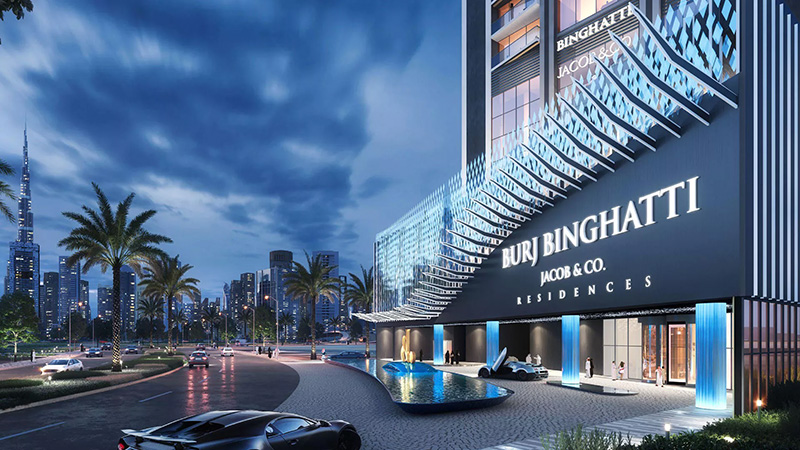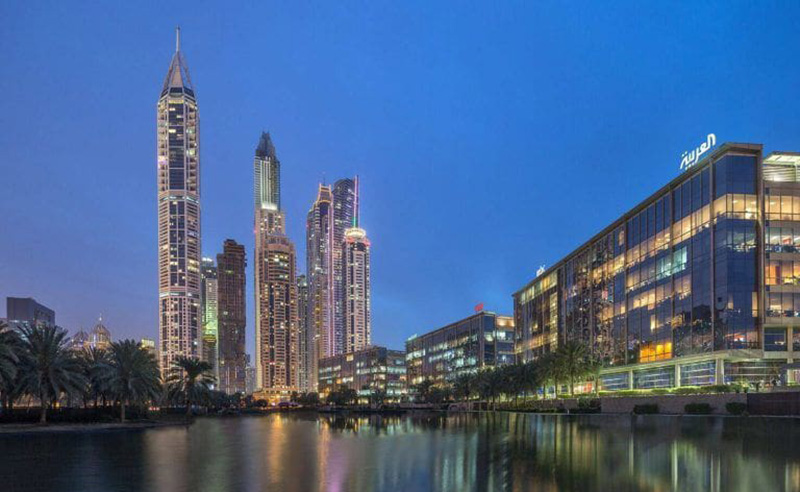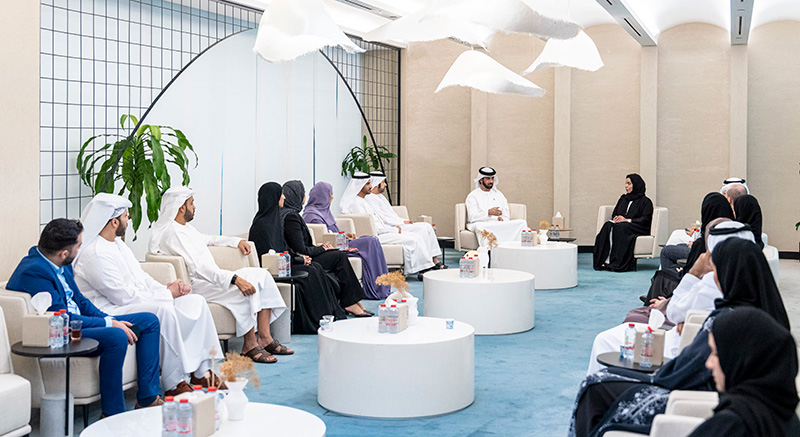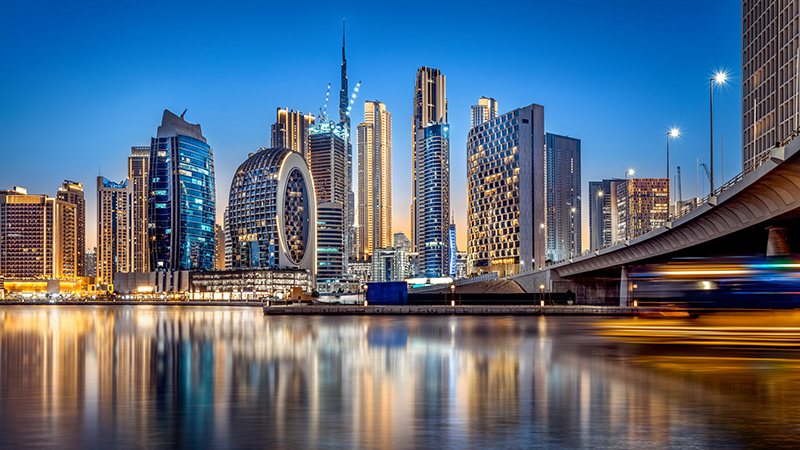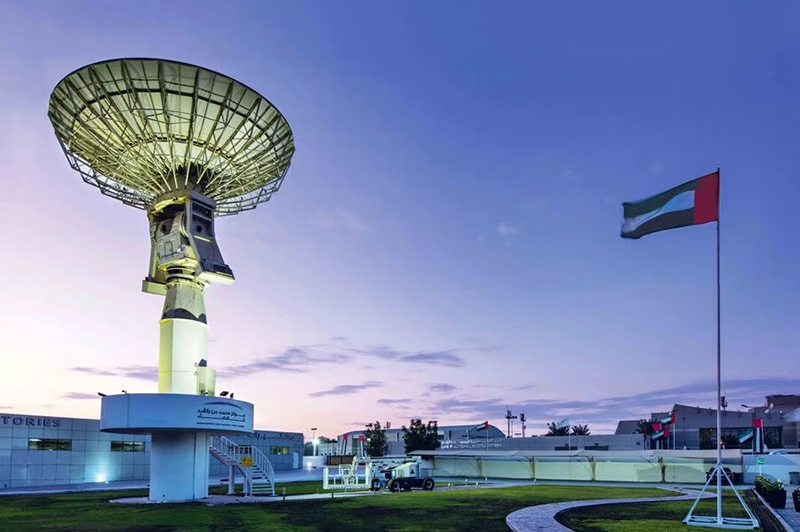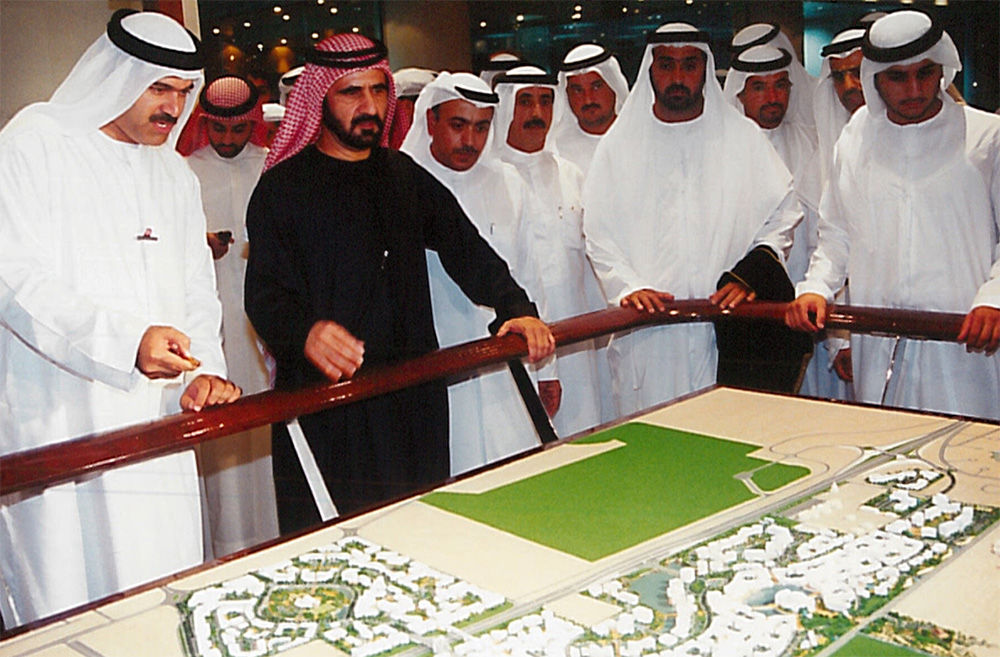
In late 1999, as the world braced for a new millennium, Dubai’s ruler took a young official, Mohammad Al Gergawi, on a drive into the quiet desert beyond the city’s limits. The vast emptiness stretched out as His Highness Sheikh Mohammad bin Rashid Al Maktoum pointed at the sands and issued a bold directive: build a city for the future, a haven for technology and innovation, right here, and do it in one year. This audacious scene encapsulated a philosophy that had gripped Dubai’s leadership: “the best way to predict the future is to invent it.” It was also grounded in Sheikh Mohammad’s conviction that “nations that foresee the future before it happens and prepare for it before others… are the nations that create that future.” The project born from that desert mandate came to be known as Dubai Internet City (DIC), an experiment in turning vision into reality, often described as an attempt to transform sand into a digital oasis.
Two decades later, Dubai Internet City stands as the heart of a thriving digital economy in the Middle East, a testament to foresight and fast execution. What began as a daring bet to ride the waves of the nascent knowledge economy has evolved into a sprawling technology hub housing thousands of companies and tens of thousands of professionals from around the globe. It is a story of bold vision and calculated risk-taking, and of how governance and policy can shape a new knowledge ecosystem. The outcomes of this experiment carry lessons not only for Dubai but for aspiring tech hubs around the world.
A Bold Vision for a Knowledge Economy
In the late 1990s, Dubai was seeking to redefine its economic model. The emirate’s leadership recognized that the future lay not in remaining confined to traditional trade and services, but in embracing a knowledge-based economy built on innovation, technology, and human capital. It was a leap prompted by an understanding that sustainable growth would require investing in knowledge and creativity as key drivers rather than relying on legacy industries. In this context, Dubai Internet City was launched in 1999 as a cornerstone of Dubai’s economic diversification strategy. The goal was clear: to catalyze a modern, knowledge-driven economy in the UAE.
When Sheikh Mohammad bin Rashid announced the plan for Dubai Internet City in October 1999, it was framed not just as an economic project but as a philosophical statement about the future. The initiative aimed to turn Dubai’s desert into a “technological oasis,” quite literally to convert sand into a digital oasis by harnessing the rapid rise of the internet and the digital revolution. This move went beyond establishing a conventional free-trade zone, it embodied a vision that technology and knowledge would be the foundations of the future. Dubai’s wager was that by proactively creating the conditions for a tech industry, it could invent the future rather than wait for it to arrive.
From Desert Blueprint to Digital City
Translating this ambitious vision into reality required an extraordinary push. Dubai Internet City was envisaged not as a slow, gradual project, but as an instant city built at start-up speed. A deadline of just 365 days was set to go from raw desert to a functioning tech cluster. Mohammad Al Gergawi, a young UAE official, was appointed to lead the project’s execution, effectively becoming DIC’s first director. With no time to waste, he began operations out of a rented building furnished with second-hand desks. Instead of state grants, the team secured a $200 million commercial loan from HSBC to fund construction, a signal that this new zone would operate with business discipline and self-sufficiency rather than as a traditional government venture. Building the physical infrastructure was only half the battle, in parallel, the team had to devise a regulatory environment tailored to attract global technology firms. They worked to provide everything the emerging digital economy would need, skilled talent, robust technical infrastructure, and clear legislation. All of this was to be delivered on a patch of sand outside the city, an empty canvas where a new industry would take root. The undertaking was as much an exercise in risk-taking as in ambition and future-thinking.
Sheikh Mohammad personally drove Al Gergawi to the barren site and underlined the urgency by giving him one year to realize not just an Internet City but also a complementary Media City on that spot, reflecting even then a vision of uniting technology and content in a single innovative ecosystem. “We started before we had companies, and before we knew if companies would come or not… but we knew that the future begins with this step,” Al Gergawi recalled about those early days. This willingness to begin without any guarantees, fueled by faith in the future, became a hallmark of the project. It broke through psychological and bureaucratic barriers, Dubai was no longer content to wait for global market shifts or for opportunities to come knocking, it would seize the initiative and create its own opportunities. In doing so, Dubai Internet City came to be measured not only by the offices built or dollars invested, but by the mindset change it instilled. It cemented a conviction that a city in the Arab world could become a producer of innovation, not merely a consumer of it.
Economic Impact and a Cosmopolitan Tech Workforce
More than twenty years on, the impact of Dubai Internet City on the emirate’s digital infrastructure and economy is both evident and profound. This high-tech zone did not just add office buildings or attract a few companies, it helped drive a structural shift in Dubai’s economic orientation and firmly placed the city on the global innovation map. In its first fifteen years alone, Dubai Internet City contributed nearly AED 100 billion (USD 27 billion) to Dubai’s economy. Today, DIC’s output constitutes the lion’s share of Dubai’s tech sector, underscoring its role as the linchpin of the emirate’s digital economy. Such figures show how the initiative evolved from a mere business park into the engine of a new economy, deeply integrated across value chains as an incubator for ideas, capital, and knowledge production.
Dubai Internet City has also become a major generator of employment. Since its inception in 1999, it is credited with creating over 125,000 direct and indirect jobs across tech sectors, and today more than 31,000 professionals from over 150 nationalities work at DIC-based companies. This fulfills one of the project’s core aims, making Dubai a magnet for technology talent from around the world. The diversity is not only cultural but also professional, spanning artificial intelligence researchers, cybersecurity experts, software developers, data analysts and more. By attracting such a cosmopolitan tech workforce, Dubai Internet City has broadened the UAE’s human capital base and created a vibrant melting pot of expertise.
Crucially, Dubai Internet City succeeded in positioning the UAE as a serious player in the global technology arena. What was once an ambitious idea is now a base for over 4,000 companies, including the regional headquarters of many of the world’s tech giants. Industry leaders from Microsoft and Oracle to Dell and Amazon Web Services have a presence in DIC, alongside social media platforms like LinkedIn and cutting-edge fintech firms such as Visa and MasterCard. The presence of these major firms in Dubai was no coincidence, it was the outcome of Dubai’s deliberate efforts to create a business environment on par with the world’s top tech hubs. Armed with advanced infrastructure, competitive incentives and high regulatory standards, the city offered an ecosystem that global companies found welcoming.
Fostering Entrepreneurship and an Innovation Culture
Beyond attracting corporate titans, Dubai Internet City set out to cultivate a homegrown innovation ecosystem. Over the years it has become fertile ground for startups and entrepreneurs, offering a supportive environment for new ventures to take root. Several of the Middle East’s tech success stories trace their roots to the DIC community. In the early 2000s, a small Arab internet portal called Maktoob was nurtured in Dubai Internet City before being acquired by Yahoo in 2009, a landmark deal that drew global attention to the region’s startup potential. That breakthrough was followed by even bigger acquisitions, Amazon’s purchase of the e-commerce platform Souq.com in 2017, and Uber’s acquisition of the Dubai-born ride-hailing app Careem in 2020 for $3.1 billion. In recent years, new ventures incubated in Dubai have reached billion-dollar “unicorn” valuations, such as the fintech firm Tabby. Each of these milestones showcased the possibility for local entrepreneurs to build companies of global significance and underscored DIC’s role as a launchpad for regional innovation.
Such achievements did not happen in a vacuum. From the beginning, Dubai Internet City consciously built a nurturing startup ecosystem alongside its big-name corporate tenants. The zone’s management under the TECOM Group established accelerators, co-working spaces and mentorship programs, and streamlined business setup procedures to ease the path for new companies. In 2013, DIC launched an in-house incubator called “in5,” which has since provided entrepreneurs with affordable workspace, training and investor access. Thanks to these efforts and a generally business-friendly climate, startups in Dubai Internet City have collectively raised several billion dirhams in funding, expanding their operations regionally and globally. Just as important, DIC became a vibrant community where innovators could meet, share ideas and inspire one another. Tech networking events, competitions and conferences found a natural home there. For instance, the annual STEP Conference, one of the region’s largest tech festivals, is now hosted on the Internet City campus, drawing thousands of participants and spotlighting local talent. Such gatherings, along with the daily buzz of a concentrated tech cluster, have helped instill a digital innovation culture in the broader society. A new generation of young Arabs has been emboldened to pursue tech entrepreneurship, encouraged by the realization that success is achievable at home in Dubai just as much as it is in Silicon Valley. In this way, Dubai Internet City’s influence radiates beyond its own precincts, fostering an attitude that the Middle East can create technological value rather than merely consume it.
Policy, Regulation, and the Power of Governance
From day one, Dubai’s leadership understood that building a physical tech park would not be enough, the enabling policy environment had to be just as cutting-edge. A key ingredient in Dubai Internet City’s success was the creation of a special economic zone framework that broke with many norms of the broader economy. In an exceptional legal step, Dubai declared DIC a free zone with its own regulatory regime, unlike elsewhere in the UAE, companies in Internet City would not need a local Emirati partner, 100 percent foreign ownership was permitted, and federal customs duties would not apply within the zone. These incentives were unprecedented at the time and provided a powerful magnet for international tech firms, which were assured a business climate as investor-friendly as any in the world.
Equally important was the establishment of tailored governance structures to run this technopolis. A dedicated authority, TECOM, Dubai Technology and Media Free Zone Authority, was set up to manage Dubai Internet City and its sister clusters, offering one-stop administration that streamlined licensing, visas and services for companies. This hands-on management ensured that bureaucratic hurdles were minimized and that the zone’s infrastructure kept pace with companies’ needs. At the same time, Dubai updated its laws to accommodate the digital era, new regulations on electronic transactions, data protection and intellectual property were enacted, creating a legal ecosystem in which tech businesses could operate with confidence. Notably, Dubai was among the first cities in the Arab world to implement an e-government initiative in 2000, digitizing public services to cut red tape for businesses and residents. This alignment of public services with digital transformation underscored the government’s commitment to making the city a hub for technology.
Underpinning all these efforts was a recognition that regulation must evolve as swiftly as technology. Sheikh Mohammad’s vision for Dubai Internet City explicitly included providing “the necessary infrastructure and environment to enable new-economy ventures to operate from Dubai.” He pressed for urgency in translating vision into rules, at the project’s launch, he gestured to the desert plot and reminded the team, “You have a year to make it happen,” signaling that every needed policy and facility had to be in place within that single year. In the years that followed, Dubai continued to roll out innovative policies to sustain momentum. Initiatives were launched to develop local digital skills, special visa schemes made it easier for global tech talent to live and work in Dubai, and government-backed funds were set up to finance tech startups. New specialized institutions such as the Digital Dubai Authority were created to coordinate the city’s expanding digitization efforts. Thanks to this adaptive governance approach, Dubai Internet City has maintained its edge and expanded its reach, all under a flexible regulatory climate that balances encouragement of innovation with prudent oversight.
A “Third Path” Among Global Tech Hubs
Dubai’s approach with Internet City was in many ways unprecedented, a hybrid model shaped by local context that nonetheless invites comparison with the world’s leading technology clusters. Often dubbed the Middle East’s answer to Silicon Valley, DIC’s model actually diverges in important ways. Silicon Valley emerged organically from the interplay of academia and venture capital, driven by a culture of open-market innovation. By contrast, DIC was a top-down initiative, meticulously planned, albeit one that harnessed market forces once the groundwork was laid. In some respects, Dubai’s strategy had more in common with Singapore’s state-driven push for a high-tech economy. Singapore pursued a deliberate government-led plan to become a global financial and tech center, leveraging its strategic location and connectivity to Asian markets. Yet Dubai did not simply copy the Singaporean model. The emirate charted what might be called a “third path,” blending market flexibility with calibrated government intervention. The creation of Dubai Internet City in 1999 was a calculated move to leap into the knowledge economy, underpinned by advanced infrastructure and carefully designed incentives to lure global players.
Comparisons can also be drawn to Europe. Berlin and Stockholm in recent years have become magnets for startups, aided by innovation-friendly policies and vibrant cultural scenes. However, their growth has been relatively gradual, reflecting Europe’s more measured approach. Dubai, by contrast, bet on speed and scale from the outset, sprinting to build an entire ecosystem in about a year, and continuing to accelerate thereafter, driven by a clear desire to put the city on the global tech map as quickly as possible. This willingness to move fast and take risks sets Dubai apart. It means that Dubai Internet City today is not a carbon copy of Silicon Valley, Singapore or Berlin, but rather a unique case, a product of proactive strategy and bold vision that turned a local disadvantage, the absence of an existing tech sector, into an opportunity to start fresh. The result is a regional tech platform that combines geographic diversity with a high degree of competitiveness.
Dubai’s success did not go unnoticed. In its wake, several other Middle Eastern countries launched their own technology parks in hopes of emulating the model. None have yet matched Dubai Internet City’s scale or impact, but the very attempt underscores the regional influence of Dubai’s model. By proving that a thriving tech cluster can be built in the Middle East, DIC challenged the notion that innovation hubs belong exclusively to Silicon Valley or a few established cities. It carved out a new spot for the Arab world on the global tech landscape, one achieved not by copying others, but by adapting global best practices to local ambition.
The Road Ahead: Vision and Reality
As breakthroughs in artificial intelligence and blockchain usher in a new digital era, Dubai Internet City stands at the cusp of a new chapter of opportunities and challenges. Having weathered the early 2000s dot-com bust and other global downturns, DIC has shown a capacity to adapt. It is already embracing emerging technologies, companies in the city explore everything from blockchain services to metaverse platforms, alongside a growing emphasis on sustainable tech innovation. Dubai’s leadership is not sitting still, in 2023 the government launched the ambitious Dubai Economic Agenda (D33), which aims, among other goals, to place Dubai among the world’s top four global financial and technology hubs by 2033. This new vision signals that the emirate intends to continue pushing the boundaries of innovation and economic development, with Dubai Internet City remaining central as an engine of growth.
Looking back, Dubai Internet City began as a gamble, the bet that a city with no real tech sector to speak of could leapfrog into the digital economy through sheer vision and will. Two decades later, that gamble has paid off. Dubai is now firmly established as the digital heart of its region. The journey of DIC offers a case study in how an emerging city can break into the global innovation race, demonstrating that a society can shape its own future through strategic, knowledge-driven development. It affirms that “the path of progress is not drawn by waiting, but by balanced action… to anticipate the future.” In the end, the future tends to favor those with the foresight to imagine it and the courage to build it.
